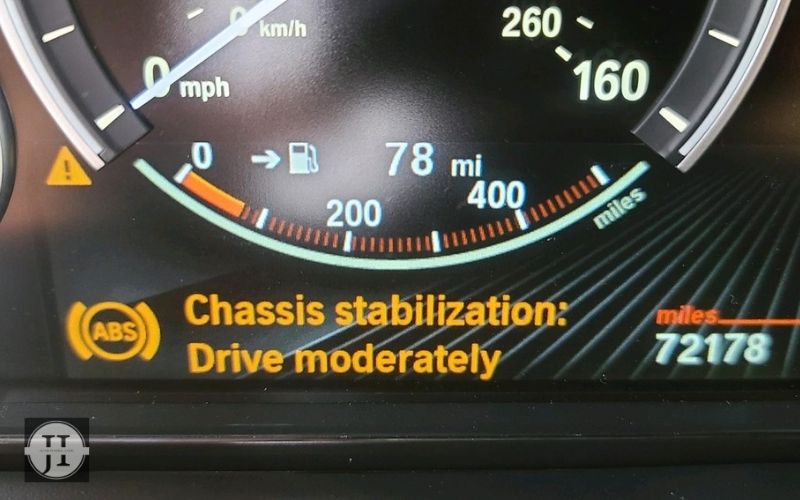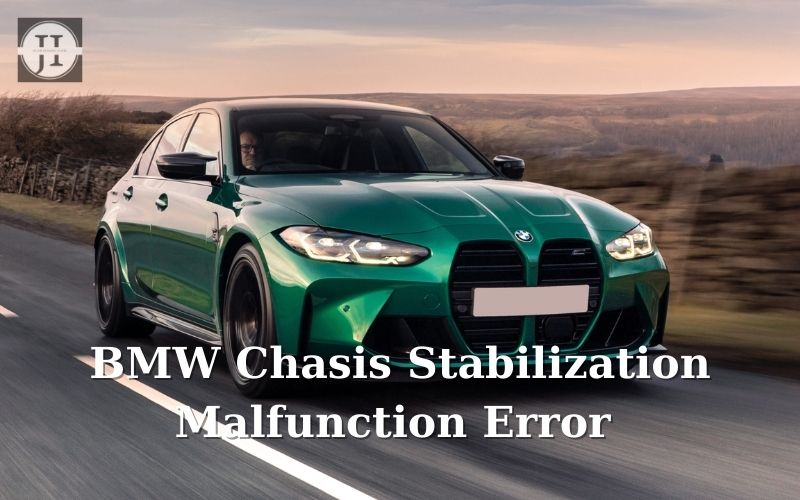Welcome to our blog post on understanding and troubleshooting the BMW Chassis Stabilization System. As a proud BMW owner, it’s essential to have a comprehensive understanding of the components that ensure a smooth and safe ride. In this article, we will delve into common causes of BMW Chassis Stabilization malfunction, the telltale symptoms and warning signs to watch out for, and how to diagnose and troubleshoot this error. We will also discuss the various methods to fix the BMW Chassis Stabilization malfunction error and the associated costs. So let’s get started and ensure your BMW stays on the road with optimal performance and stability.
Understanding The BMW Chassis Stabilization System
The BMW Chassis Stabilization System is an integral part of the vehicle’s suspension system, designed to enhance stability and improve handling. This system, also known as Dynamic Stability Control (DSC) or Electronic Stability Control (ESC), uses various sensors and computer algorithms to constantly monitor the car’s movement and make necessary adjustments to keep it on the intended path.

One of the key components of the Chassis Stabilization System is the electronic control unit (ECU), which receives data from sensors placed throughout the vehicle. These sensors measure variables such as wheel speed, steering angle, lateral acceleration, and yaw rate. Based on this information, the ECU can detect any deviations from the desired trajectory and activate specific components to intervene and stabilize the vehicle.
The Chassis Stabilization System utilizes several mechanisms to achieve its purpose. One crucial element is the Anti-lock Braking System (ABS). When the system detects wheel lock-up during heavy braking, it modulates the brake pressure to each wheel individually, allowing the driver to maintain steering control. This helps to prevent skidding and potential loss of control.
The Chassis Stabilization System also incorporates the Traction Control System (TCS), which works in conjunction with the ABS. If the sensors detect excessive wheel spin, indicating a loss of traction, the TCS will reduce engine power and apply the brakes to the spinning wheel(s), helping to maintain grip and stability.
Additionally, the Chassis Stabilization System includes the Electronic Brakeforce Distribution (EBD) feature. This feature ensures that the braking force is applied appropriately to each wheel, depending on the vehicle’s weight distribution and the severity of the braking demand. It optimizes braking performance and stability under various driving conditions.
The Chassis Stabilization System also collaborates with the Powertrain Control Module (PCM) and the Transmission Control Module (TCM) to further enhance stability. If the system detects excessive oversteer or understeer, it can selectively reduce engine power and modify transmission settings to assist in correcting the vehicle’s trajectory.
In conclusion, the BMW Chassis Stabilization System is a sophisticated technology that plays a vital role in maintaining stability and safety while driving. Understanding its components and functions can help drivers appreciate the importance of regular maintenance and prompt diagnosis of any malfunctioning issues. By addressing the common causes associated with Chassis Stabilization Malfunction, owners can ensure the system operates optimally, providing a comfortable and secure driving experience.
Common Causes Of BMW Chassis Stabilization Malfunction
The BMW Chassis Stabilization System is an important component in ensuring a smooth and stable ride. However, there are certain factors that can lead to a malfunction in this system. Understanding these common causes can help you diagnose and address any issues that may arise.
1. Sensor Malfunction: One of the primary causes of chassis stabilization malfunction is a faulty sensor. Sensors are responsible for detecting any imbalance or movement in the vehicle and sending signals to the system to adjust accordingly. If these sensors are not functioning properly, it can result in an error in the stabilization system.
2. Electrical Issues: Electrical problems can also lead to a chassis stabilization malfunction. Wiring harnesses, connectors, or even the control module itself can get damaged or experience corrosion over time. This can disrupt the flow of electrical signals, causing errors in the system.
3. Mechanical Damage: Another common cause of chassis stabilization malfunction is mechanical damage to the suspension components. This can happen due to wear and tear or impact from road hazards. Damaged struts, control arms, or bushings can affect the proper functioning of the stabilization system.
4. Environmental Factors: Extreme weather conditions, such as heavy rain, snow, or extreme heat, can also contribute to a chassis stabilization malfunction. Moisture or debris can interfere with the sensors or cause corrosion, affecting the system’s performance.
5. Software Glitches: As with any electronic system, software glitches can occur in the chassis stabilization system. These glitches may result in temporary malfunctions or errors in the system. Keeping the software up to date and addressing any known software issues can help prevent such malfunctions.
6. Wear and Tear: Over time, the components of the chassis stabilization system may experience wear and tear. This can include worn-out bushings, ball joints, or control arms. As these components deteriorate, they may not provide the necessary stability, leading to a malfunction.
It is important to note that a chassis stabilization malfunction can pose a safety risk, as it affects the vehicle’s stability and handling. If you notice any warning signs or symptoms of a malfunction, it is advisable to have your BMW inspected by a qualified technician. They will be able to diagnose the specific cause of the error and recommend the necessary repairs or replacements. Remember, addressing the underlying cause is crucial to ensure the proper functioning of the chassis stabilization system and maintain a safe driving experience.
| Common Causes | Effect |
|---|---|
| Sensor Malfunction | Disruption in system adjustment |
| Electrical Issues | Interference with electrical signals |
| Mechanical Damage | Impact on suspension components |
| Environmental Factors | Interference due to weather conditions |
| Software Glitches | Temporary malfunctions or errors |
| Wear and Tear | Deterioration of stability components |
Symptoms And Warning Signs Of Chassis Stabilization Error
As a BMW owner, it’s important to be aware of the various warning signs and symptoms that may indicate a chassis stabilization error in your vehicle. The chassis stabilization system is a critical component of your BMW, designed to enhance handling and stability on the road. When this system malfunctions, it can lead to a compromised driving experience and potentially dangerous situations. By recognizing the warning signs, you can take proactive measures to diagnose and address any issues before they escalate.
One of the most common symptoms of a chassis stabilization error is an illuminated warning light on your dashboard. This warning light is specifically designed to alert you to any issues with the stabilization system. It is often represented by an icon resembling a vehicle with wavy lines underneath, indicating instability. If you notice this warning light consistently appearing, it’s crucial to have your BMW inspected by a qualified technician to determine the cause.
In addition to the warning light, there are several other signs to look out for. One of these is unusual steering behavior. If you notice that your steering feels loose or unresponsive, especially during turns or at higher speeds, it could be a result of a chassis stabilization error. The system is responsible for optimizing the distribution of torque between the wheels, and when it malfunctions, it can impact the responsiveness and control of your BMW.
Another potential indicator of a chassis stabilization error is abnormal vibrations or noises. If you experience vibrations or hear strange noises coming from the chassis, especially while driving on uneven surfaces or navigating corners, it could be a sign of a malfunctioning stabilization system. These vibrations and noises may be accompanied by a noticeable decrease in overall vehicle stability.
It’s important to note that a chassis stabilization error can be caused by various factors. Damage to the chassis, worn-out suspension components, or electrical issues can all contribute to a malfunctioning system. It’s recommended to have your BMW regularly serviced and inspected by a certified technician to minimize the likelihood of such errors occurring.
In summary, understanding the symptoms and warning signs of a chassis stabilization error is essential for any BMW owner. By being vigilant and proactive in addressing these issues, you can ensure the safety and performance of your vehicle. If you notice any warning lights, unusual steering behavior, vibrations, or noises, it’s crucial to seek professional assistance and diagnosis. Remember, a well-maintained chassis stabilization system is essential for a smooth and secure driving experience in your BMW.
Diagnosing And Troubleshooting The Chassis Stabilization Malfunction Error
One of the most common issues that BMW owners may encounter is a chassis stabilization malfunction error. This error occurs when there is a problem with the chassis stabilization system, which is responsible for maintaining the stability and control of the vehicle. Understanding the causes, symptoms, and how to diagnose and troubleshoot this error can help you address the problem effectively and ensure the safety of your BMW.
If you encounter the chassis stabilization malfunction error in your BMW, it is important to diagnose and troubleshoot the issue promptly. Here are some steps you can take:
- Scan for error codes: Using a diagnostic scanner, check for any error codes related to the chassis stabilization system. These codes can provide insights into the specific component or area experiencing the malfunction.
- Inspect wiring and connections: Thoroughly inspect the wiring and connections of the chassis stabilization system. Look for any signs of damage, loose connections, or corrosion that may be causing the error.
- Test sensors: Perform sensor tests to determine if any sensors are faulty. This can be done using specialized diagnostic tools or with the help of a professional BMW technician.
Diagnosing and troubleshooting the chassis stabilization malfunction error in your BMW is essential for maintaining both the performance and safety of your vehicle. By understanding the common causes, recognizing the symptoms, and taking appropriate steps for diagnosis and repair, you can effectively address the issue and ensure a smooth driving experience.
Fixing The BMW Chassis Stabilization Malfunction Error and The Cost
If you own a BMW, you may have encountered the frustrating issue of a chassis stabilization malfunction error. This error can negatively affect your driving experience, making your car feel unstable and unsafe on the road. However, with proper diagnosis and troubleshooting, you can fix this issue and get your BMW back to its optimal performance. In this blog post, we will discuss the common causes, symptoms, and warning signs of chassis stabilization malfunction, as well as the steps you can take to diagnose and fix the error.
One of the common causes of the BMW chassis stabilization malfunction error is a faulty sensor. The sensor is responsible for detecting any irregularities in the vehicle’s suspension system and relaying that information to the control module. When the sensor malfunctions, it can send inaccurate data, leading to a destabilized chassis. Additionally, issues with the control module or wiring can also contribute to the error.
To diagnose the chassis stabilization malfunction error, you can start by using a diagnostic tool compatible with BMW vehicles. This tool will help you retrieve error codes stored in the control module and provide insights into the specific problem causing the malfunction. Once you have identified the faulty component, you can proceed with the necessary repair or replacement.
Once you have identified the cause of the chassis stabilization malfunction error, you can proceed with the necessary repairs. The cost of fixing this error can vary depending on the specific component that needs replacement or repair. For example, replacing a faulty sensor may be relatively affordable, while repairing the control module or wiring can be more costly. It is recommended to consult with a professional BMW technician or mechanic to get an accurate estimate of the repair cost and ensure the proper fixing of the error. Remember, addressing the chassis stabilization malfunction error promptly will not only enhance your driving experience but also contribute to your safety on the road.
| Component | Estimated Cost |
|---|---|
| Sensor | $100 – $200 |
| Control Module | $500 – $800 |
| Wiring | $300 – $500 |
In conclusion, a chassis stabilization malfunction error in your BMW can be a frustrating issue to deal with. However, by understanding the common causes, symptoms, and warning signs, as well as effectively diagnosing and troubleshooting the error, you can successfully fix it. The cost of fixing the error may vary depending on the specific component that needs repair or replacement. It is essential to consult with a professional technician to ensure an accurate diagnosis and proper fixing, ultimately restoring your BMW’s stability and safety on the road.











